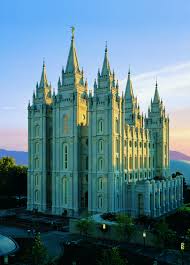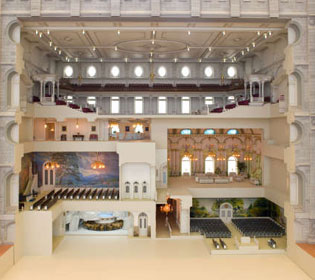Difference between revisions of "Salt Lake Temple"
m |
m |
||
| Line 1: | Line 1: | ||
| − | [[Image:Salt-Lake-Temple-2019. | + | [[Image:Salt-Lake-Temple-2019.jpg|500px|thumb|<center><span style="color:#0000FF">Salt Lake Temple</span></center>|right]] |
The Salt Lake Temple was the sixth [[Mormon Temples|temple]] completed by [[The Church of Jesus Christ of Latter-day Saints]] and the fourth finished after the Mormon pioneers' arrival in what is now the state of [[Utah]]. Its construction took 40 years, and it stands as a striking emblem of the Latter-day Saints' dedication and perseverance. It is also the most well-known temple and has come to symbolize the Church to many throughout the world. | The Salt Lake Temple was the sixth [[Mormon Temples|temple]] completed by [[The Church of Jesus Christ of Latter-day Saints]] and the fourth finished after the Mormon pioneers' arrival in what is now the state of [[Utah]]. Its construction took 40 years, and it stands as a striking emblem of the Latter-day Saints' dedication and perseverance. It is also the most well-known temple and has come to symbolize the Church to many throughout the world. | ||
Revision as of 09:45, 24 April 2019
The Salt Lake Temple was the sixth temple completed by The Church of Jesus Christ of Latter-day Saints and the fourth finished after the Mormon pioneers' arrival in what is now the state of Utah. Its construction took 40 years, and it stands as a striking emblem of the Latter-day Saints' dedication and perseverance. It is also the most well-known temple and has come to symbolize the Church to many throughout the world.
In late July of 1847, the first group of Latter-day Saint pioneers entered the Salt Lake Valley. Within a few days, their leader Brigham Young indicated the precise location where the holy edifice should stand by striking the ground with his cane and announcing, "Here we will build a temple to our God." Apostle Wilford Woodruff marked the spot then and there. Construction of the temple began on 14 February 1853, following a groundbreaking ceremony conducted by Brigham Young.
A granite deposit was found nearby, and workers began to hand-chisel massive granite blocks which weighed between 2,500 and 5,600 pounds. These large stones were transported by ox-drawn wagon (and later railroad) to the temple lot. Most of the labor was performed by volunteers who, despite their hardships in trying to settle a new land, gave freely of their time and skills. Brigham Young encouraged the Saints to make the Salt Lake Temple the best it could be. The prophet stated that he wanted "to see the Temple built in a manner that it will endure through the Millennium" (Journal of Discourses, 10:254). The temple was built accordingly. Brigham Young also worked extensively with architect Truman O. Angell, directing what the temple was to look like according to the visions and revelations that were given to him by the Lord. The architectural style of the temple is often described as Gothic, complementing the doctrinal symbolism and revelatory layout of the temple.
There were numerous challenges which slowed the construction of the temple. At one point Church leaders learned that a U.S. Army contingent was being sent to Utah. Latter-day Saints distrusted the government that had allowed them to be persecuted and pushed out of Illinois, Missouri, Ohio, and New York, so the work on the temple was stopped and the entire foundation was buried. As positive relations developed between the U.S. Government and the Church, work on the temple was resumed. The foundation was uncovered, but workers found that there were cracks in the foundation blocks. They were forced to take them out and start over, using new stones that were cut to fit together without mortar.
The Saints worked tirelessly to build the 253,015 square-foot temple. Once the exterior was completed, skilled artists and craftsmen were brought in to complete the temple's 170 rooms. The interior furnishings were completed in one year, marking 40 years since the groundbreaking ceremony. The Salt Lake Temple became the largest temple, with 12 sealing rooms and four ordinance rooms (after various additions and remodeling). With over a hundred temples constructed since then, it still remains the largest in the Church.
The Salt Lake Temple is also unique in that the President of the Church presided directly over a temple. Elder David B. Haight related why he felt this temple received such special attention:
- "The work of this great temple was so significant to these men that they were willing to carry the additional responsibility of presiding over it and looking after its operation—in essence going to the temple each morning and taking care of business there before going to do the work of the First Presidency of the Church ("Symbol of Sacrifice, Monument to Life," Ensign, Oct. 1993, 9).
Unfortunately, Brigham Young did not live to see the completion of the Salt Lake Temple; nor did his successor, John Taylor. The temple was finally finished under the direction of Wilford Woodruff, then the fourth president of the LDS Church. Dedicatory services took place on 6 April 1893. Many other dedicatory services followed, providing "opportunity for eighty-two thousand people to participate in presenting their temple to their God" (Wallace Alan Raynor, The Everlasting Spires: The Story of the Salt Lake Temple, Salt Lake City: Deseret Book Co., 1965, p. 159).
J. Golden Kimball of the First Council of the Seventy said the following about what the Salt Lake Temple meant to him:
- When I think about [the temple], every stone in it is a sermon to me. It tells of suffering, it tells of sacrifice, it preaches—every rock in it, preaches a discourse. When it was dedicated, it seemed to me that it was the greatest sermon that has ever been preached since the Sermon on the Mount... Every window, every steeple, everything about the Temple speaks of the things of God and gives evidence of the faith of the people who built it (Conference Report, Apr. 1915, p. 79).
Contents
Scaled Model of Salt Lake Temple Gives Open House Experience
In May of 2010, an 88-inch tall scale model of the Salt Lake Temple was put on display in the South Visitors' Center in Temple Square. The scaled replica is 1:32 and shows the interior rooms of the temple.
- The model of the Salt Lake Temple sits in front of a giant window in the South Visitors' Center facing the actual building that it replicates. The south and east walls of the replica have been cut away to show depictions of many of the rooms in the temple, including the large assembly hall and rooms where the First Presidency and Quorum of the Twelve Apostles meet. The baptistery and other ordinance rooms are also depicted. Close attention is paid to detail, and even paintings, furniture and working chandeliers and lamps imitate those found in the actual temple.
- Peter McCann Architectural Models of Toronto was commissioned to create the replica in August 2009. Sixteen modelers with different expertise in various parts of the duplication process worked on the project for five months.
- "This replica will show the millions of visitors who come to Temple Square the beauty and majesty of this sacred and historic building," said Elder Richard G. Hinckley, executive director of the Missionary Department. "Like all temples, once the building is dedicated it is used for sacred Church purposes and not open to the general public, but this exhibit will provide the public with a glimpse of the interior and a feeling of the Spirit that is present there."
- The Salt Lake Temple is a landmark known throughout the world. When it was last open to the public in April of 1893, the local press reported that approximately 5,000 people, most of whom were not members of the Church, toured the temple before the dedication. The reports went on to say that "altogether the richness and elegant workmanship of the temple was a revelation of wonder to the visitors."
- "Many people think our temples are like great halls or cathedrals. Actually, they have a number of rooms designed for certain functions such as marriages, baptisms, and instructional sessions," said Elder William R. Walker, executive director of the Church’s Temple Department.
- In addition to the scaled model, the new display in the South Visitors' Center features new kiosks that show high-definition photos and video of the Salt Lake Temple interior rooms. A narrator gives an explanation of the purpose of the rooms and a diagram shows where they are located on the model. The presentation is very similar to what a person would experience during the public open house of a temple. [1]
- To see a video describing the scale model and display, click here.
See also Temple Square
External Links
- Official Salt Lake Temple Website
- Salt Lake Temple page
- Temple Square as a Mission
- Mormon Temples - Lightplanet
- Mormon Temples and Secrecy
- Mormon Temple Ordinances - ReligionFacts
Videos of the Salt Lake Temple
Temples in Utah
- Bountiful Utah Temple
- Brigham City Utah Temple
- Cedar City Utah Temple
- Deseret Peak Utah Temple
- Draper Utah Temple
- Ephraim Utah Temple
- Heber Valley Utah Temple
- Jordan River Utah Temple
- Layton Utah Temple
- Lehi Utah Temple
- Lindon Utah Temple
- Logan Utah Temple
- Manti Utah Temple
- Monticello Utah Temple
- Mount Timpanogos Utah Temple
- Ogden Utah Temple
- Oquirrh Mountain Utah Temple
- Orem Utah Temple
- Payson Utah Temple
- Price Utah Temple
- Provo City Center Temple
- Provo Utah Rock Canyon Temple
- Red Cliffs Utah Temple
- Salt Lake Temple
- Saratoga Springs Utah Temple
- Smithfield Utah Temple
- St. George Utah Temple
- Syracuse Utah Temple
- Taylorsville Utah Temple
- Vernal Utah Temple
- West Jordan Utah Temple

